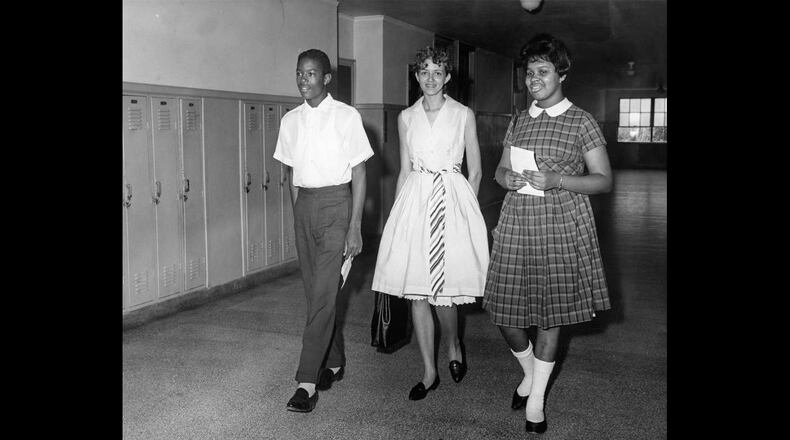The aim of school integration in the South was Black and white students sitting side by side, learning and achieving together. That vision of racial balance did not foresee the discrimination and resentment that Black students would encounter in mixed-race schools, according to a new paper by four noted economists.
Despite the widely held ideal about the value of racial balance, the researchers found Black adults who attended mixed-race schools where the enrollment was racially balanced ended up completing fewer years of schooling and were less likely to graduate than peers who attended overwhelmingly white schools or predominantly Black schools. They also were less likely to go on to own homes, a significant factor especially among Black women.
Conventional wisdom has long maintained that Black students fare better in integrated schools because those schools offer more resources in terms of the quantity and quality of teachers per student, equipment, books and materials, classrooms, and curricula.
But the study suggests the hostilities aimed at Black students once they reach a critical mass offsets any edge gained from those greater resources. “Our hypothesis, which appeared to have been borne out by the work we did, was that, in the schools in which you had greater racial balance, whites experienced a greater sense of threat by the presence of Black students there,” study co-author William A. “Sandy” Darity Jr., director of Duke’s Samuel DuBois Cook Center on Social Equity and a professor of public policy, African and African American Studies and economics, said in a telephone interview.
Culling data from the National Survey of Black Americans, a representative survey of Black Americans age 18 or older, the researchers examined experiences and outcomes of 1,121 Black adults ages 25 to 65 in 1979-80. These adults categorized the peers in their high school as: “mostly or almost all white,” “mostly or all Black,” or “about half Black,” where the enrollment was racially balanced. A rich and unique data set, the survey provided a deep dive into the lives of Black Americans. An updated version was administered in the early 2000s, but it did not ask respondents about the racial composition of their high schools.
In earlier research, Darity and paper co-author Darrick Hamilton, director of the Institute for the Study of Race, Stratification and Political Economy at The New School, found that discrimination rises when the dominant group believes its position and status are at risk. When Black students represented only a fraction of the school population, whites were not threatened, said Darity.
However, when Black students became a larger presence in schools, white kids and their parents saw them as competitors for teacher attention, seats in desirable classes, and positions of status in the school involving leadership, athletics and academics. That led whites to double down on their advantages and guard them.
Almost 20 years ago, at a University of North Carolina conference on why schools were resegregating, john powell, then director of the Kirwan Institute on Race & Ethnicity at Ohio State University, said Black parents had become disillusioned with integration programs that took their children out of their neighborhoods to distant white schools where they faced second-class status. “Many African American parents are aware of in-school segregation, and that’s why they no longer support making a car ride an hour across town to a high-achieving school with white kids and their kid ends up sitting in the basement,” said powell, who does not capitalize his name.
Unequal opportunities within a school can take root in subtle ways, said lead author Timothy M. Diette, a Washington and Lee University economist. (Diette is also the local school board chair in his Virginia town, so he can see the influence of parents on school practice and policy firsthand.)
White parents may better understand how to work the system on their children’s behalf, Diette said. For example, they may ask why their children are assigned to a generic math rather than algebra and push to switch them. Or, if their children are denied gifted services, they may resort to private testing to earn them a qualifying score.
“There are very few limits on what parents may do to preserve turf for their children,” said Darity, citing the recent college admissions scandal where wealthy parents paid thousands of dollars to buy their children’s way into select schools with faked test scores and sports accomplishments.
Even in contexts where it appears students have a choice to enroll in advanced and honor courses, Darity said, “Work I did earlier shows that once you set up the initial conditions in which Black students are absent from those choices, other Black students are unlikely to enroll in such classes because they anticipate being isolated. The system is self-perpetuating even when there are no actual barriers to entering the classes.”
Darity said one solution of some schools is to stop limiting gifted classes to a few students and provide that level of instruction to everyone in the building, which can lead to improvement in the performance of all students. “But that would eliminate the hierarchy that some people prefer,” he said.
While the study looked at historical outcomes, Diette said the message today is that schools and workplaces have to broaden their goal from diversity to inclusion. Opening the doors to people of color is not enough.
“For me, the key takeaway here is the notion of really thinking very deliberately and intentionally about inclusion and about how we do that,” said Diette in a telephone interview. “Who is identified as gifted? Who gets the rigorous classes? Who gets the attention in the classroom?”
The focus for too long has been on the desegregation of schools at the facility level rather than ensuring quality instruction for Black students within schools, said Darity, who, as a child in the early 1960s, integrated Glenwood Elementary School in Chapel Hill.
“The idea we can solve the achievement gap through merely engaging in greater integration of schools is not accurate,” said Darity. “There is much more that has to be done, in terms of what happens within the schools. The internal school practices are really critical in terms of establishing student outcomes. We frequently want to say the students come from families that are poor or neighborhoods that are less safe and the like. Yes, those things do come into play, but what is decisive is what happens within the walls of the schools themselves.”
Darity says there is retreat underway now from integrated schools, largely due to segregated housing patterns. That still leaves the challenge, he said, “to ensure Black students have quality instruction regardless of where they go to school.”
To that end, Darity cited a comment by civil rights pioneer W.E.B. Du Bois, who said in 1935 that theoretically, “the Negro needs neither segregated schools nor mixed schools. What he needs is Education.”
About the Author
The Latest
Featured



